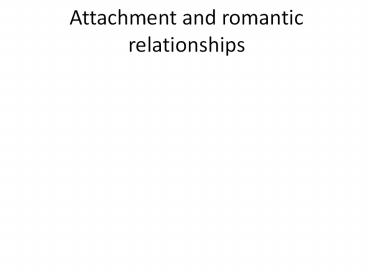Attachment: From the cradle to the grave - PowerPoint PPT Presentation
Title:
Attachment: From the cradle to the grave
Description:
Can I count on my attachment figure to be available ... Parent - Peer (friend) concordance. Peer Partner (romantic) concordance. Not Parent Partner ... – PowerPoint PPT presentation
Number of Views:215
Avg rating:3.0/5.0
Title: Attachment: From the cradle to the grave
1
Attachment From the cradle to the grave
- Hazan Shaver, 1994
- New article JPSP?
2
Close relationships as attachments
- Prototypical pair bond
- Attachment
- Care-giving
- Sexual mating
- Integrated under attachment?
- Maybe sexuality is or can be different?
3
Three features
4
Attachment Review
5
Can I count on my attachment figure to be
available/responsive?
- Yes Secure
- Exploration
- No Insecure/Avoidant
- Defensiveness
- Maybe Insecure/Resistant
- Anxiety
6
Attachment development
7
Relationship Development
8
Generic Insights
- Miscommunication sex vs. safe haven
- Attachment can prolong relationship
- Surface after relationship dissolution
- For both instigator and recipient
- Rumination, searching or avoidance
- Evidencing attachment bond
9
Specific insights
- Security (55)
- Needs met, successful conflict resolution
- Avoidance (25)
- Needs unexpressed, infidelity?
- Resistance (20)
- Needs unmet, remaining in unsatisfactory
relationships? - Sex differences not evident
- Attachment develops before gender roles
10
Attachment formation to partner
11
Parent ?? Peer ?? Partner
- Attachment representations of the three
relationships are distinct yet related - Attachment style
- Parent - Peer (friend) concordance
- Peer Partner (romantic) concordance
- Not Parent Partner
- Peer relationships appear to be a mediator
- Why?
- Furman et al.
12
Hazan, C. Shaver, P. R. (1994). Attachment as
an organizational framework for research on close
relationships. Psychological Inquiry, 5(1), 1-22.
- Attachment Theory
- Humans predisposed to form close relationships
- satisfy most fundamental basic need for security
- Supported by behavioral systems related to
survival and reproduction - Attachment, caregiving, sexual mating
- Individual differences adaptation of behav
systems to social environment - E.g. attachment styles
- Maintained by mental models
- Expectations that attachment figure will respond
that self will be responded to - Resistant to change (over-learned, subconscious,
default strategy of assimilation) - Somewhat flexible (through reflection,
corrective relationship experiences)
13
Attachment from Infancy to Adulthood
- Attachment behaviors shift from parent to peers
- Early childhood Early adolescence Adulthood
- proximity maintenance ? proximity maintenance
? proximity maintenance - safe haven safe haven
- secure base
14
Fundamental questions
- What makes a potential relationship partner
appealing? - Cues for attachment system familiarity
responsiveness - similarity to ourselves, mere exposure, positive
response to us, anxiety - Cues for caregiving system
- babyness, distress (shift at puberty)
- Cues for sexual mating system
- evidence of youth and health
- How is a relationship formed, developed?
- Initiated by motivation for physical proximity
- may be from attachment system or sexual mating in
adults - Both infants and adults look for signs of
responsiveness - Bond strengthens as partner becomes safe haven
- sensitive, responsive care becomes more important
than attraction
15
Fundamental questions
- What makes relationships satisfying or enduring?
- how well they meet basic needs for comfort, care,
sexual gratification - at least compared to alternatives
- fear of separation from attachment figure
activates attachment system - even if needs not being met
- Why do relationships dissolve?
- relative importance of basic needs changes
- lack of caregiving exposed when sexual passion
declines - What are the reactions to relationship breakup?
- attachment system activated
- separation-protest to seek proximity
- sadness detachment
- re-attachment to another
- sometimes premature
16
Fundamental questions
- What makes relationships satisfying or enduring?
- how well they meet basic needs for comfort, care,
sexual gratification, (exploration) - at least compared to alternatives
- fear of separation from attachment figure
activates attachment system - even if needs not being met
- Why do relationships dissolve?
- relative importance of basic needs changes
- lack of caregiving exposed when sexual passion
declines - What are the reactions to relationship breakup?
- attachment system activated
- separation-protest to seek proximity
- sadness detachment
- re-attachment to another
- sometimes premature
17
Individual differences
- Predictable strategies for maintaining felt
security - Inconsistent responsiveness ? anxious/ambivalent
attachment - preoccupation with keeping others close (fall in
love easily, early self-disclosure) - intense expression of distress (view partners as
insufficiently responsive) - diminished exploratory behavior
- Consistent unresponsiveness ? avoidant attachment
- avoiding intimacy
- compensatory engagement in non-social activities
(work) - regulation anxiety through other means
(uncommitted sex, substance use, distraction) - Gender
- no differences in attachment styles
- females more oriented to caregiving, males to sex































